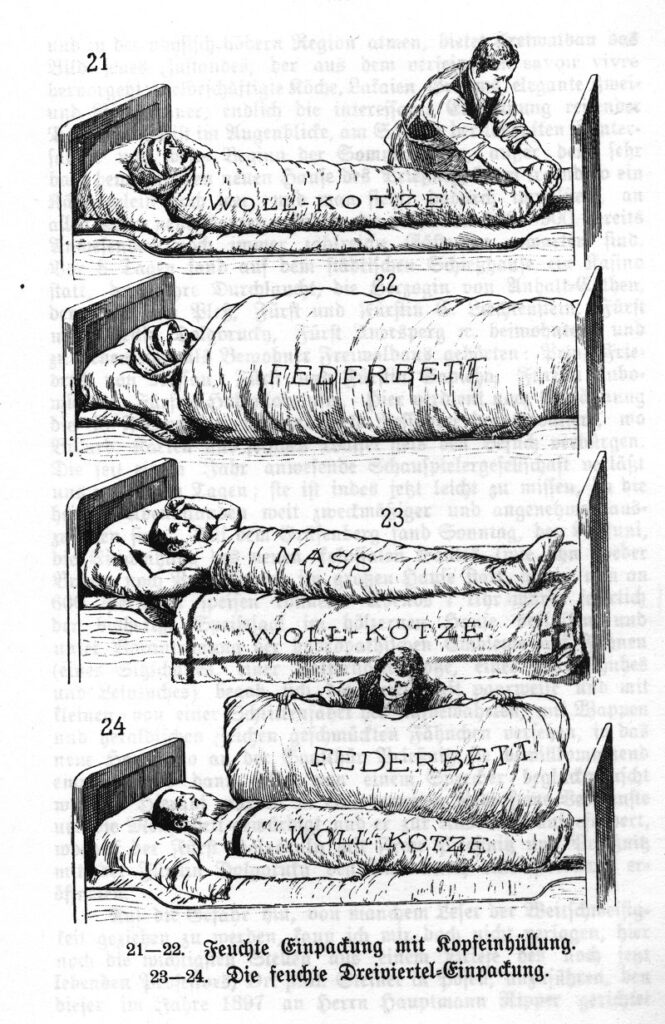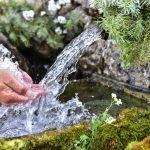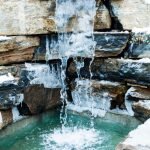Vincent Priessnitz & the Blanket Pack
Sussanna Czeranko, ND, BBE
Nature Cure Clinical Pearls
Not the cold but the heat produced by the cold water is the healing factor.
Vincent Priessnitz
If I understand the matter rightly, Priessnitz never was in the habit of using the wet sheet for sweating, only the dry blanket.
Joel Shew, MD, 1849, p.100
Now began the packing up, and soon my very handy host had wrapped me so tight and so close that I could not move or stir.
Jesse Mercer Gehman, p.12
Twice now I have begun an article whose purpose was to explore the early literature about friction and rubs, only to be side-tracked by a related but quite different topic. Such is the delight and abundance of this literature from our forebears. The topic of “friction” was the side-tracking culprit in this case. Friction – the act of rubbing the body to stimulate circulation and warm the body – was an integral part of hydrotherapy. We were first introduced to friction as a therapeutic intervention with the work of Vincent Priessnitz. Adding to this rich tradition were the successes of Louis Kuhne and Adolf Just. The use of friction assisted the physiological effects of short exposure to cold water to augment blood circulation and warming. Friction was subsequently adopted by the early 20th century hydrotherapists.
It was during my research on Vincent Priessnitz’s use of friction that I found a curious and precious book, Hydriatics, Manual of the Water Cure (1842), written by someone who had the auspicious providence of actually receiving water treatments by Priessnitz. Francis Græter’s comprehension of Priessnitz’s work was articulated in his book about this eminent Father of Hydrotherapy. I became immersed in Græter’s book, and before I knew it, my original topic made a sharp detour to Græfenberg, Austria. Alas, I did not return to the topic of Friction and Rubs. Another small treasure found in NUNM’s Rare Book Room, entitled Vincenz Priessnitz: the wonderful power of water in healing the diseases of the human body, was authored in 1844 by Dr Chr. Charles Schieferdecker and was published in Philadelphia. My search did not end here, though; then I found yet another outstanding book describing in minute detail the work of Priessnitz. The book, The Water Cure Manual, was written in 1849 by Joel Shew, MD. Græter’s, Schieferdecker’s, and Shew’s books collectively offer us unusual and rare accounts, especially powerful because these men actually witnessed and experienced hydrotherapy at the side of Priessnitz.
Vincent Priessnitz
What we know of Priessnitz’s childhood is that he faced many disappointments and hardships. Lust recounts, “Vincenz Priessnitz was born on October 4, 1799 in Græfenberg. He was the son of a poor blind farmer and early, when other children spent their time playing, young Vincenz had to look after his father’s little farm.” (Lust, 1900, p.2) At the age of 8, Priessnitz was forced to quit school and assume the responsibility for the family farm because his father had become blind and unable to work. Caring for cattle gave him opportunities “to observe the instincts of his flock and the wild animals that came near him.” (Schieferdecker, 1844, p.18) From his repeated observations, keen perception, and intuitive analysis of how animals used cold water to heal themselves, Priessnitz translated his observational data into personal testing. For example, he applied cold water to himself when he had broken ribs, with outstanding results.
Overcoming the Limits of Illiteracy
Unlike Sebastian Kneipp, who had the opportunity to study at a seminary, thus gaining an education, and who wrote 3 classic books on hydrotherapy, which proliferated hydrotherapy around the world, Priessnitz was almost illiterate. Priessnitz’s work did not have the same exposure because his abilities to write and communicate his observations and applications were truncated. Consequently, Priessnitz did not leave behind any books about his work, and the inevitable, invaluable clinical pearls were left to be reported by others who observed him. They, in turn, recorded the theoretical framework of Priessnitz’s life work. Through the writings of Græter, Schieferdecker, and Shew, we are exposed to Priessnitz and can come a little closer to the views and principles that guided his work. Sadly, thus, Priessnitz himself was unable to be the author of any publication that could be left for future generations to cherish; however, his followers and students of his methods have bridged some of that gap for us.
Stuffs
To understand Priessnitz’s work, one must first grasp some of his concepts of disease and his healing rationale. Priessnitz lived at a time when the talk of humors and bodily fluids dominated medical paradigms and theories of healing and balance. Bad humors, which Priessnitz referred to as “stuffs,” resulted in disease and had to be removed from the body. Græter’s account of such aspects of Priessnitz’s work has survived to this day with an objectivity and sincerity that are important features of this tradition. He writes, “Whether [Priessnitz] be in the right in ascribing all diseases, or at least their causes, to the humors, I do not presume to decide; the results, however, of a consistent use of his cure speak in favor of his opinions … for generally he cures.” (Græter, 1842, p.70)
Priessnitz identified disease caused by bad humors accumulating in the body because of harmful habits of eating unhealthy food, overeating, suppressed secretion by the skin, lack of exercise, and “violent mental excitements … such as anger, vexation, sorrow and grief.” (Græter, 1842, p.71) His inclusion of mental and emotional states as a causation for bad humors is noteworthy because this mind-body thread would permeate the foundation of naturopathic philosophy that gained purchase in the healthcare terrain a half-century later. In regards to the emotions or mental states contributing to the etiology of disease, we are given the following counsel: “We can become masters of our anger, we can avoid the occasions for it; by means of reason we can gain a less gloomy view of our sufferings; by simplifying and limiting our wants we may diminish our cares.” (Græter, 1842, p.73)
Priessnitz recognized the role of emotions in disease etiology as equally significant causal factors alongside practices such as the over-prescribing by Allopaths of their infallible mercury that led to the accumulation of bad humors, thus contributing to indigestion and a host of other diseases. Græter also records Priessnitz’s discovery that perspiration was, in fact, not only a cooling mechanism in the body, but also a means of eliminating unwanted waste matter. He writes: “By the millions of little openings (pores) with which it is thickly sown in every part [of the body], the finest fluids, useless for the nutrition of the body, are removed.” (Græter, 1842, p.32) The goal of hydrotherapy was to increase the elimination of impurities and unwanted waste matter. To begin to truly appreciate Priessnitz, we begin by understanding his descriptions of the immense importance of the skin in its role in excretion. Through the millions of skin pores, impurities found in the blood can be eliminated. Priessnitz recognized that perspiration and bathing had a significant impact upon skin by increasing its activity and thus its contributions and effectiveness in overall health.
Perspiration, the Essence of Priessnitz’s Cure
As Schieferdecker points out, in water cure, or the hydriatic method of curing, “the application of the coldest water alone (without the help of ice or any artificial means) entirely ejects all material causes of disorders, under whatever form they may appear, from every part of the human [body].” (Schieferdecker, 1844, p.51) Water had the power and distinct benefits, including: “invigorating the [body], promoting evaporation, and by preparing better humors.” (Græter, 1842, p.74) Schieferdecker elaborates further on the benefits of hydrotherapy: “Water does not operate at all as a medicine, but only by its power of destroying every substance inimical to life.” (Schieferdecker, 1844, p.53)
Priessnitz’s primary focus in his therapies was to improve the skin’s function of perspiration. The essence of cure was to find ways to draw diseased matter towards the skin for excretion. One interesting point made by Græter is that along with the loss of bad matter (or humors) during the perspiration process, was the loss of good substances. (Græter, 1842, p.76) The one caveat that we can tuck in the back of our minds is that the good prevailed. Eventually, the bad humors were excreted and replaced by the good humors.
Græter provides insights into Priessnitz’s views on the “how to” of this critical therapy: “A gentle perspiration, moderate bathing or washing, drinking of nothing but cold water, and abstaining from all sharp, fat and sour victuals, are the best means for assuaging their sufferings.” (Græter, 1842, p.76) For Priessnitz, “sour victuals” meant tea, coffee, chocolate, alcohol, pepper, cloves, mustard, and salted fish. (Græter, 1842, p.71)
Perspiration essentially improves the skin’s primary function of eliminating toxins and waste through the skin pores. Priessnitz’s observation was that when sick people were able to perspire, they would recover very quickly afterwards. “As soon as the perspiration has once found its way, you will feel easier, and the alleviation is increased by the opening of the windows and drinking of water.” (Græter, 1842, p.81) The Priessnitz “sweating treatment” was considered to be superior to the vapor or steam baths because there was no disruption to the blood circulation or respiratory system. Græter goes on to say, “This sudorific method [is so effective and safe], that it can be applied daily for the space of months and even years without ever producing weakness.” (Græter, 1842, p.81)
The Sweating Process
Inducing perspiration as a therapeutic process can potentially be misunderstood. Shew writes: “A great many seem to think that sweating is the only mode by which disease is to be removed. They appear to imagine that disease is a tangible thing that may be brought out.” (Shew, 1849, p.100) He continues on the subject of sweating by citing Priessnitz: “Sweating is a debilitating process, and should, therefore, be avoided, and that nature expels disease by the invigoration of the general health.” (Shew, 1849, p.100) This statement by Priessnitz can confound us a little, because he used sweating so deliberately in his patients. However, the literature reveals that he also used the blanket pack and induced perspiration in patients as the invariable preparatory step for the real therapeutic intervention of the cold water application.
Priessnitz, Shew, and others knew that the optimal method to achieve sweating or perspiration was via physical exercise or hard labor. In this regard, Shew writes, “If a person does not habitually labor or exercise so that at least moderate perspiration is experienced upon the surface, then good and uninterrupted health cannot last long.” (Shew, 1849, p.101) Priessnitz used his blanket sweating procedure for patients who did not have the vitality or strength for exercise or labor.
In any case, being packed up for sweating was a principle treatment used by Priessnitz. This process of perspiration involved a unique treatment used by Priessnitz, which did not incorporate any “wet sheets”; rather, the pack consisted entirely of blankets. The dry pack for sweating referred to the bundling of a patient snugly in a large, coarse, woolen blanket (Figure 1). Great attention was given in Priessnitz’s dry sweating pack to ensure that the sheet and the blankets were wrapped tightly. “The most attention is to be given to the tight closing of the blanket round the neck and the feet, where it most easily gets loose.” (Græter, 1842, p.82) Once wrapped up, more blankets and duvets would be piled on top of the patient. Schieferdecker presents details: “As many blankets as [the patient] could conveniently bear were heaped upon him, and on these a [feather duvet], so as effectually to exclude the external air.” (Schieferdecker, 1844, p.ix) The patient, wrapped in a dry pack, “remains quiet and sleeps, if he can, until the perspiration comes forth, when he most frequently awakens; or he rubs his hands against each other or upon his thighs or makes any other motion to accelerate perspiration.” (Græter, 1842, p.83) Dr Engel of Vienna gives the following account: “The invalid is [awakened] at four or five o’clock in the morning, then enveloped almost hermetically in a thick, coarse, woolen blanket, the head only is left uncovered, by which all contact with the exterior air is carefully avoided.” (Gehman, date unknown, p.8)

Figure 1. The Blanket Pack
For those with arthritis, hot fomentations, in the form of glass bottles filled with hot water and wrapped with a towel, would be placed near “the suffering parts, tumors of the bones, arthritic lumps, etc.,” inside the dry pack. (Græter, 1842, p.83) The dry pack was ideal, in particular, for the “arthritic persons and to the sufferers from the abuse of mercury.” (Græter, 1842, p.82) It is interesting to note that mercury, probably in the form of Calomel, was such a concern in the days of Priessnitz that the dry pack was already understood to be an important detoxification methodology for this heavy metal.
Another important step in the Priessnitz dry pack was the attention given to fresh, open air. “As soon as the sweat is running, the windows are opened and the patient commences drinking with intervals of [15 to 30 minutes] between every tumbler [glass].” (Græter, 1842, p.83) These 2 elements – opening the window for air and drinking frequent glasses of cold water – enhanced the patient’s comfort during the process of perspiration and helped to prolong the patient’s time in the dry pack. A caution: “Drinking must not be carried so far as to make the sweat to stop.” (Græter, 1842, p.83)
Patients packed up in the sweating pack would be bundled for at least 3 to 4 hours, and, in some cases, longer. It took most patients at least an hour before beginning to perspire. At this point the patient would remain in the pack, perspiring for 2 to 3 hours more, and never longer than 4 hours. The duration of the perspiration period was individualized based upon the patient’s constitution and circumstances. It is no wonder that the blankets and mattress of the beds in which patients laid were penetrated by copious amounts of perspiration. Græter reports that containers were placed under the bed for the perspiration and “that often several quarts [were] collected.” (Græter, 1842, p.84)
Drinking during the dry sweat pack was encouraged only after the perspiration appeared and not before. “Cold water as a drink dilutes, thins, dissolves, and evacuates.” (Gehman, p.13)
Patients who overheated [determined by checking if the patient’s head felt very hot] indicated that it was “time to be unpacked and to go the bath.” (Græter, 1842, p.84) If, however, it was deemed that the patient would benefit from a longer time in the dry pack, then a cold compress was placed on the forehead and under the head.
The dry pack was a preliminary step before administering a cold bath. The dry pack increased the body heat in a patient so that he or she could endure the cold bath, which followed more easily. When the cold bath was indicated, patients were unpacked, protected with a robe, and quickly ushered to the bath area, “avoiding as much as possible any exposure of the perspiring body to the air.” (Græter, 1842, p.85) Patients would enter the cold baths while perspiring, which was considered very safe and healing. Any delay between the sweat phase and the cold bath would consequently cool down the body too much and prevent the reaction phase from occurring. Warmth that had developed within the body during the sweating phase was a necessary factor in Priessnitz’s method of eliminating the “stuffs,” or impurities.
Priessnitz’s bath tubs were uncommonly huge. Græter reports that these tubs or basins were “of 20 to 30 feet circumference, and sufficiently deep to reach the chin of a sitting person.” (Græter, 1842, p.87) At the bath, the patient washed his or her face and chest and would essentially plunge into the cold water. The cold plunge activated the skin with a reaction that was “visible in the high redness which the skin presents after each bath. This redness after the bath and douche is accordingly a very good sign of the expected cure, as it testifies of a sufficient vital power and activity of the skin.” (Græter, 1842, p.85) Water was understood in such treatment protocols as the ultimate way of dissolving the morbid matter of the body and getting rid of it.
Græter noted that at Priessnitz’s Græfenberg facility, many of the patients would undertake 2 dry packs in a day, 4 AM and 4 PM. (Græter, 1842, p.84) Our tolerance levels today would not easily allow such uncomfortable and inconvenient compliance as waking so early in the dead of night to take a treatment beginning at 4:00 in the morning! Those who showed up at Priessnitz’s door were so sick and so desperate for relief, though, that objections to his prescriptions were rare, if at all.
Four O’clock, Treatment Begins!
A typical day at Græfenberg began at 4 AM when a bath attendant showed up at the patient’s room with a large, coarse, woolen blanket to prepare for him or her as a dry pack for sweating. This dry pack could last for 4 hours. Towards 8 AM, the patient would take a cold bath and immediately thereafter would walk for about 30 minutes. During the walk, patients would drink lots of water. Priessnitz had his patients drink upwards of “12 glasses of water every day, as the minimum. Many take as many as thirty tumblers [glasses] per day; habit and daily perspiration increase the capacity for [drinking water] considerably.” (Græter, 1842, p.99)
For newcomers to the treatment, drinking such copious amounts of water often resulted in vomiting or diarrhea, which aided in the purification process that was the objective of Priessnitz’s therapeutic goals. These symptoms disappeared very quickly. The best time for drinking water was on an empty stomach before breakfast and during exercise. Drinking after a bath was not encouraged.
After the water drinking and walk, breakfast was taken, which consisted of cold milk, brown [rye] bread, and fresh butter and fruit. (Gehman, no date, p.9) After breakfast came a short walk along with more water drinking. At 11 AM, patients arrived at the bath house, where douches were administered. At 12 PM, lunch was served, lasting about 2 hours. This was a time when people could converse and visit or take a walk before they assembled to take an excursion for 2 hours, facilitating perspiration. At 4 PM, the second dry-sweat packing was given, which lasted until 7 PM. This was followed by baths and a walk. At 8 PM, supper was served, followed by entertainment that included a music concert, recital, or dance. Before retiring to bed, a sitz bath or compress would be administered.
The Bath
The water used by Priessnitz was very cold. Its coldness was one of the features that was responsible for its salubrious effects. The coldest of waters were used in Græfenberg. Priessnitz theorized that cold water’s main effect was that of dislodging and eliminating unwanted or diseased materials. The cold water on the skin causes blood to circulate from the body’s surface deep into the interior of the body. With each cold bath, “there will consequently be below the skin a new mass of matter to be secerned from the organism and sucked off by the water.” (Schieferdecker, 1844, p.55)
In the bathtubs at Græfenberg, there was a steady stream of water. Patients did not sit in stagnant waters. By contemporary standards, this plumbing of tubs in Priessnitz’s era must have been quite peculiar. In a cold water bath at 5° to 8° Reaumur/43° to 50° F/6° to 10° C, the duration of a bath would not exceed 6 or 8 minutes; however, 1 to 3 minutes was the average length of time spent in such cold water. By any standard, this is an incredibly long time to be in such cold water. Perhaps that is why people who came after Priessnitz, such as Sebastian Kneipp and others, shortened the length of their cold baths. Kneipp would often counsel his patients to go into a cold bath, count to 3 or 5, and get out immediately. We cannot say that Priessnitz was soft in his approach. The temperature in the facilities where the baths were taken were only a few degrees warmer than the water temperatures, and the rooms where the patients returned to for rest were no warmer than the bath houses.
Sometimes, during the treatment, fevers and skin eruptions, such as boils, abscesses, or ulcers would appear, often exuding “corrupt matter in great quantities.” (Gehman, p.14) Priessnitz’s confidence and composure in treating these healing crises were indicative of a master at work. He knew what to do in these cases and acted quickly, calmly, and confidently. At his disposal were baths, either a full or a half-bath or a sitting bath; douches; wet sheets; enemas [clysters]; compresses; and friction. He used these tools with precision and success.
In the next issue, we will look at a number of Priessnitz’s water applications and review some of the cases of patients who visited his Hydriatric Institute.
References:
Gehman, J. M. (unknown date).
Græter, F. (1842). Hydriatics, Manual of the Water Cure. New York, NY: William Radde Publisher, pp. 198.
Lust, B. (1900). A brief history of natural healing. The Kneipp Water Cure Monthly, 1 (1), 2-5.
Schieferdecker, C. C. (1844). Vincenz Priessnitz: the wonderful power of water in healing the diseases of the human body. Philadelphia, PA: Published by author, pp. 140.
Shew J. (1849). The Water Cure Manual. New York, NY: Fowlers and Wells, pp. 288.
 Sussanna Czeranko ND, BBE, incorporates “nature-cure” approaches to primary care by including balneotherapy, breathing therapy, and nutrition into her naturopathic practice. Dr Czeranko is a faculty member working as the Rare Books curator at NCNM and is currently compiling a 12-volume series based upon Benedict Lust’s journals, published early in the last century. Her published books include: Origins of Naturopathic Medicine; Philosophy of Naturopathic Medicine; Dietetics of Naturopathic Medicine; Principles of Naturopathic Medicine; Vaccination and Naturopathic Medicine; and Physical Culture in Naturopathic Medicine. Dr Czeranko is the founder of the Breathing Academy, a training institute for naturopaths to incorporate a scientific model of breathing therapy called Buteyko into their practice. She is also a founding board member of the International Congress of Naturopathic Medicine and a member of the International Society of Medical Hydrology.
Sussanna Czeranko ND, BBE, incorporates “nature-cure” approaches to primary care by including balneotherapy, breathing therapy, and nutrition into her naturopathic practice. Dr Czeranko is a faculty member working as the Rare Books curator at NCNM and is currently compiling a 12-volume series based upon Benedict Lust’s journals, published early in the last century. Her published books include: Origins of Naturopathic Medicine; Philosophy of Naturopathic Medicine; Dietetics of Naturopathic Medicine; Principles of Naturopathic Medicine; Vaccination and Naturopathic Medicine; and Physical Culture in Naturopathic Medicine. Dr Czeranko is the founder of the Breathing Academy, a training institute for naturopaths to incorporate a scientific model of breathing therapy called Buteyko into their practice. She is also a founding board member of the International Congress of Naturopathic Medicine and a member of the International Society of Medical Hydrology.










